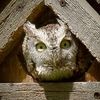focusing on BIF
Nov 3, 2013 21:12:24 #
Everyone, I need some educating. I use a Nikon D70 camera with a Nikkor 55-300 4.5-5 zoom lens. I have been trying to capture birds in flight with some difficulty. I start with the lens at the 55 mm end and when I get the subject in focus I slowly zoom in. Against a blue sky I lose focus. Sometimes I can't even get focus at the 55 end. I seem to have better luck when there is some sort of background, but the sky is almost always unsuccessful. I also have a D3000 Nikon. Does the camera make a difference or is it something that I am doing? Any help would be appreciated. Thank you in advance for your help.
Nov 4, 2013 08:55:22 #
manderson wrote:
Everyone, I need some educating. I use a Nikon D70... (show quote)
Hi Manderson, thanks for posting your question. There are a few camera settings that you should be using that will help. #1 is that your focusing mode should be AF-C or continuous tracking mode. #2, if your lens has Image Stabilization, turn it off. The fast, erratic motion of following a BIF is not what IS was intended to be used for and with many lens/camera combinations it can interfere with autofocus. Instead you should be shooting at a high enough shutter speed that you don't need it anyway.
Zooming out to find the bird and then zooming in to frame it is a legitimate technique when shooting BIFs. However, I don't usually start to focus until I have zoomed in. With the bird filling much more of the viewfinder, the camera should have an easier time seeing what you what to focus on than when that bird is just a tiny spot. You need to learn to keep the AF points on the bird when you are focusing and tracking so that it doesn't focus on something else.
There is a wealth of info on this section of the forum and I would suggest you start with the sticky post I have at the top of the page on shooting BIFs or just click on: http://www.uglyhedgehog.com/t-88437-1.html
The D70 is a nearly 10 year old design, and, although newer systems have gotten better and better at tracking motion, your camera should be adequate for shooting all but the smallest birds.
Post some pictures so we can see what you are getting and don't forget to click on store original.
Good Luck!
Nov 4, 2013 14:59:00 #
birdpix wrote:
Hi Manderson, thanks for posting your question. Th... (show quote)
Thank you for your help. Didn't think about the vibration reduction being turned to the off position.
Dec 10, 2013 12:06:55 #
Bram boy
Loc: Vancouver Island B.C. Canada
manderson wrote:
Everyone, I need some educating. I use a Nikon D70... (show quote)
it's the camera , the D70 was a dog of a camera from all the reports I have read on it . you have to up grade to the D300 or a D 7000 or if you can find one for a decent price a D 700 fx
Dec 14, 2013 07:57:47 #
There is a lot to learn about this type of photography. Then, once you know what to do to get the shot, it take lots and lots of practice. Don't get discouraged just keep learning and trying. One thing that helped me was to try to capture images of leaves as they fell from a tree before they hit the ground.
At some point you will be able to find the subject in the viewfinder with the lens on 300mm. You should try it at 800mm, talk about a learning curve. Just have fun and keep checking UHH posts for support.
At some point you will be able to find the subject in the viewfinder with the lens on 300mm. You should try it at 800mm, talk about a learning curve. Just have fun and keep checking UHH posts for support.
Dec 14, 2013 18:28:24 #
Bram boy
Loc: Vancouver Island B.C. Canada
Gary Truchelut wrote:
There is a lot to learn about this type of photogr... (show quote)
I practice on sea gulls as there is hundereds down at the fish boat dock
If you want to reply, then register here. Registration is free and your account is created instantly, so you can post right away.


